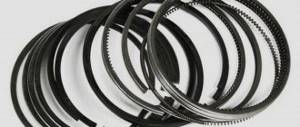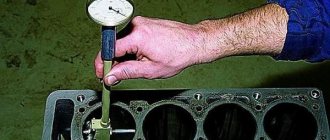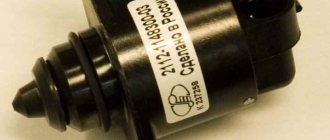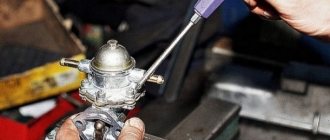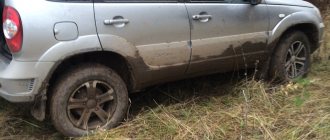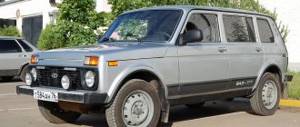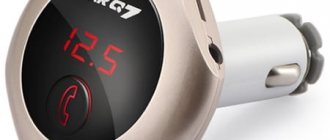Main types
Based on the type of construction, there are two types of overpasses for cars:
- Full-size ones allow you to repair a machine that is completely raised above ground level by 1 meter. They are bulky and require a lot of space. Suitable for both passenger cars and trucks.
- Mini overpass. It consists of two small, independent from each other, beveled on one side of the podium. The auto overpass allows you to lift the car from the front or rear wheels. Used for partial inspection of the bottom. The disadvantage of this design was the need for the driver to have pinpoint precision when driving on it.
Stationary
Full-size overpasses are of the stationary type. They are installed along highways, on roadsides, and at service stations. The platform is raised high above the ground and allows for a detailed inspection of the car from the bottom and for carrying out repair work. Designed to support the weight of cars and trucks.
The strongest and most durable structure is made of metal. To create an observation deck, brick, wood, pipes and channel are used.
Advice! If the garage is built for 2 cars, but there is only one there, then the free space can be allocated for your own overpass.
Collapsible
The collapsible overpass has smaller dimensions. It fits easily in the garage and, if necessary, is quickly assembled. Designed for inspection of a passenger car.
The design includes:
- 4 stands for supports;
- 2 pairs of platforms with a stopper to prevent the car from rolling away;
- 2 pairs of horizontal ramps for inclined access;
- several stiffening ribs for fixing parts relative to each other.
They are built from metal. The thicker and more durable the material chosen, the longer the structure will last.
Popular options for overpasses for car repairs
The simplest type of mini-overpass is two pairs of scraps of wooden beams with a cross-section of 20x20 cm knocked together. By cutting the edge of such an impromptu support at an oblique angle, we get a strong platform onto which you can drive the front end or back the car (photo No. 1).
The disadvantages of such a support are obvious: there are no sides on the beam to protect against lateral sliding of the wheels, which requires the driver to be extremely careful when entering. There is also no rear bumper to prevent an accidental slide. The height of the stand is not sufficient for easy access to the bottom.
There is a more advanced version of a wooden support for simple repair work. Such a flyover at the dacha is made from scraps of boards, sequentially knocked down into a wide board. One side of it forms a stepped slope for entry (photo No. 2).
General requirements
Making an overpass is not a complicated process, but you need to remember a few nuances:
- The height of the full-size version is up to 1 meter, and the mini version allows you to raise the car by 0.3-0.7 meters.
- The width of the structures is determined by the width of the car. To make it easy to access, the ramps and platforms are made 0.4 meters wide. These dimensions are sufficient for most wheels.
- The safety margin determines the service life. In the mini model it is not so critical, and when building a stationary overpass they do not skimp on materials.
The overpass, assembled independently, should fit in ordinary garages. When creating a drawing, take into account how much free space there is to store it.
Stages of preparatory work
Carrying out the work yourself, from the design stage to final assembly, is not difficult. To do this, you need to decide on the type of construction, the preferred and available material, make a drawing, calculate the dimensions and number of parts, make an estimate for the purchase of material, and rental of equipment.
Calculation of dimensions and drawing up drawings
Start creating a drawing by selecting the type (stationary or portable) and material. Each person will have their own preferred shape of the product. General dimensions:
- height – up to 1 meter;
- width – about 0.4 meters;
- lifting length – about 1 meter;
- the length of the flat platform is from 0.3 meters.
An overpass is a pair of identical structures. On the side of the diagram, its shape resembles a rectangular trapezoid. A pair of slides can be additionally fixed to each other to avoid displacement while the machine is being lifted onto it.
Preparation of materials and tools
Depending on the material, tools are selected for the overpass. A structure made of sleepers or metal is assembled using:
- welding machine;
- Bulgarians;
- bolts, nuts.
The main material is reinforcement and a 40 mm corner. The finished structure is coated with anti-corrosion paint on top.
A wooden overpass is created from:
- wooden blocks with a square cross-section with a side of 0.2 meters;
- wooden blocks or boards;
- nails, screws;
- saws;
- screwdrivers.
How to make a collapsible car overpass yourself?
The manufacturing of the structure begins with the preparation of a detailed drawing. When doing it, you will be able to take into account and think through all the stages of assembly, avoiding the mistakes inherent in hastily completed work.
The collapsible overpass must have the following dimensions:
- The length of the entrance and horizontal ramp is equal to the length of the car + 1 meter.
- The width of the ladder is at least 40 cm.
- The height of the supporting pedestals is 70-80 cm.
- The width of the upper part of the support pedestals is equal to the width of the ladders.
In order to make the overpass durable, you should not skimp on metal. For drains you need to buy a 63 mm equal angle angle. Supporting pedestals “chairs” can be welded from a corner with a shelf width of 50 mm. The filling of the drains is done with corrugated reinforcement with a cross-section of at least 14 mm.
It is better not to start work without a welding machine, grinder and drill. In addition to the assembly tool, you need to prepare 12 pairs of bolts and nuts for attaching the ladders to the “chairs”.
Stages of work
The first step is making the support pedestals. They need to be given a trapezoidal shape to increase stability. To accurately assemble the base and upper part of the “chair,” the corners cut to size must be laid out on an OSB board, secured together using clamps or welder magnets.
First, the lower bases of all four supports are welded. Then the frames of the upper platforms are assembled and the legs from the corner are attached to them. The final stage is the installation of the upper frames with legs into the lower supports and fixing them by welding.
Please note that in the assembly diagram one of the corners of the upper frame is turned upside down and forms a bumper to protect the wheels from falling off the overpass. One more fender corner needs to be welded on the end supports. They will not allow the car to move off the ramp.
In order to make the overpass with your own hands as stable as possible, you can install cross braces on it from a steel profile. It is bolted to the pedestals. This measure will not be superfluous, since it will increase the rigidity of the entire structure.
The horizontal and entrance ramps are made from a 63 mm angle and reinforcing bars that act as a “ladder”. The length of the inclined ramp for a passenger car must be at least 3 meters. The size of the horizontal section is selected by adding 1 meter to the length of the car. The width of the ladders is at least 40 cm.
Before installing the reinforcing bars, the corners are turned over so that their flanges face up and serve as outer side edges. The “ladder” will be level if the profile is laid on a solid horizontal platform. It is difficult to attach it to concrete or asphalt. Therefore, you can use two transverse angles as a mounting base. The guide “ladders” are attached to them with clamps. Having completed this operation, you can begin the welding process. It will be more convenient to align sections of profiled reinforcement using a 63 mm corner piece as a template.
Making an inclined ramp for an overpass for car repairs is slightly different from assembling a horizontal one. You need to leave a free end 10 cm long on it (without reinforcing bars), which will serve as a connecting point. The vertical edge of the profile is cut with a grinder to the horizontal shelf. After this, it is necessary to bend the connecting ends.
If you don’t have a bending machine, but have a couple of friends of considerable weight, then ask them to climb onto the pedestal to counterbalance the bending force. Before this operation, you need to lay the entrance ramp horizontally, supporting its free end. Two holes are drilled locally in the supporting part of the profile and the corner of the “chair”. Having fixed the ends of the “ladder” with bolted connections, it is tilted with force down to the ground. In the place where the profile was cut, you need to weld a piece of steel plate to strengthen the support unit.
The horizontal ladder is mounted by laying it on pedestals. After this, holes are drilled for the bolts in the supporting corners and the upper support profile of the cabinet. For more reliable fastening of the overpass to the site, eyes can be welded to the “chairs”. By fixing them with dowels to the concrete or steel pins to the ground, you will protect yourself from the displacement of parts of the overpass when a car enters it.
When making a test drive, pay attention to the behavior of the inclined “ladder”. If it bends, you will have to make two intermediate support frames and bolt them to the corners.
If you don’t have an inspection hole for your car, you can replace it with a flyover you made yourself in the garage or at your dacha. To do this you will need a couple of sleepers and a few thick boards or some scrap metal, a welding machine and a grinder. Of course, a pit in a garage is more convenient, but for various reasons not every garage can be equipped with one. The proximity of underground communications or groundwater can interfere, and then, if you want to repair your personal car, the solution for you will be to build an overpass with your own hands.
DIY metal structure
The most popular is a mini overpass made of metal. This product has a number of advantages:
- easy to move;
- ease of assembly - does not require special skills;
- reliability and durability.
Although a do-it-yourself overpass can last for decades, over time any structure wears out. If you properly care for it and treat it against rust, its service life will increase significantly.
Welding of the structure proceeds as follows:
- a corner is cut and two rectangular trapezoids are assembled;
- connect them together with a corner;
- using scraps and remnants of the corner on the sides, additional stiffening ribs are formed;
- the reinforcement is cut and welded onto the upper base and inclined plane;
- cleaned with a wire brush and painted with metal paint.
The procedure is repeated for the second part of the trestle pair. You can make a limiting side on the upper platform to prevent the car from passing further. It is convenient to store it vertically.
Overpass for full entry of the car (photo on the right):
all-welded construction of increased rigidity.
Bolted connections in places where partitions are attached between ramps. Width adjustable only if partitions are replaced. Withstands the weight of medium-duty (Gazelle, Sobol, etc.) and small trucks. Side boards on each ramp. It takes up a lot of space and is often used in truck service centers. The overpass is used for technical inspection, cleaning the body from rust, replacing spare parts, painting, etc. To the order form
Instructions for making a wooden mini trestle
Wooden construction is characterized by low cost of materials. The advantages also include:
- simplicity of design. It does not require special tools and equipment; it can be made using available materials;
- the mobile overpass has a relatively light weight;
- mobility - easy to set up and remove.
The disadvantages include a small margin of safety. Over time, the timber overpass will rot and be undermined by insects. Special treatment will help increase service life.
There are two types of portable wooden overpass:
- One piece. Take a beam with a cross-sectional side of at least 0.2 meters. Connect it with nails to another cut. A bevel is cut off from one edge. The height of such an overpass is small, but it is lightweight and can be stored in the trunk of a car.
- Stepped. It is created from blocks and 50 mm boards. The pads are cut into pieces. Depending on the height, some are cut off from one edge. The structure is assembled in layers: a board, on it, with a certain step, several blocks are nailed, and again the board. Each tier is shorter than the previous one. Stops at the required height. A motion limiter block must be placed on top. The smaller the angle of inclination, the easier it is for the car to drive. But this lengthens the overpass and makes it heavier.
Technology for creating a brick structure
A type of stationary structure is a brick product. For construction it is necessary to allocate a plot of land. A homemade overpass is no different in shape from metal or wood. All parts are built from brick.
The construction method involves creating classic brickwork with cement mortar. The advantage of this automotive alternative to the inspection pit is its strength. It can withstand the weight of even a truck.
The disadvantages include:
- the need to allocate a sufficiently large plot of land for it;
- installation, as well as dismantling, requires a lot of time;
- Over time, the masonry collapses and requires its hollow demolition.
Such a structure is more suitable for garages in villages and outside the city, where there is a lot of free space. The brick is chosen to be as durable as possible. Construction work is best carried out in the warm season.
Overpass or inspection hole?
Inspection pits have long been universally recognized, so when approaching the construction of a garage with all seriousness, many motorists do not forget about this detail. But the problem is not the carelessness of the builders, but, on the contrary, the responsibility. The fact is that not in every area the soil allows you to make a recess for an inspection hole. For example, if the groundwater is high, then instead of a pit for car repair, you risk getting a pool of ice water.
Of course, if you make high-quality waterproofing, even with high groundwater levels, you can protect yourself, but the likelihood of a breakthrough will still remain. It is precisely in such cases, when for a number of reasons it is impossible to make an inspection hole, an overpass comes to the rescue.
An overpass is a platform for a car, which allows you to easily carry out technical inspections or repairs under the bottom of the vehicle.
Compared to an inspection pit, the overpass has many advantages:
- large area for work;
- more natural light falls on the work surface and it is easier to install additional lighting;
- conditions are more comfortable;
- not as damp as in the inspection hole.

